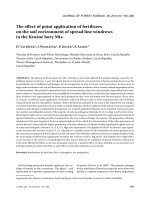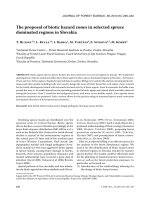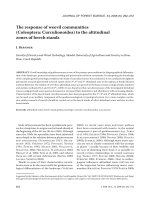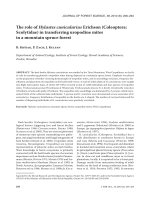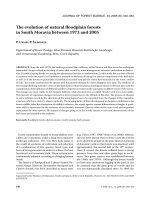Báo cáo lâm nghiệp: "The effects of stock type and radicle pruning on blue oak morphology and field performance" docx
Bạn đang xem bản rút gọn của tài liệu. Xem và tải ngay bản đầy đủ của tài liệu tại đây (443.83 KB, 8 trang )
Short
note
The
effects
of
stock
type
and
radicle
pruning
on
blue
oak
morphology
and
field
performance
DD
McCreary
University
of
California,
Sierra
Foothill
Research
and
Extension
Center,
8279
Scott
Forbes
Road,
Browns
Valley,
CA
95918,
USA
(Received
10
November
1994;
accepted
2
November
1995)
Summary —
Blue
oak
(Quercus
douglasii
Hook
&
Arn)
acorns
were
germinated
and
divided
into
three
groups
or
stock
types.
The
first
group
was
directly
sown
in
the
field;
the
second
was
sown
into
con-
tainers
and
grown
for
4
months
before
outplanting;
and
the
third
was
grown
for
a
year
before
out-
planting.
In
addition,
each
of
these
groups
was
further
divided
into
three
radicle
pruning
treatments:
i)
radicles
left
intact;
ii)
2-3
mm
cut
from
radicle
tip;
and
iii)
radicles
pruned
back
to
1
cm.
Results
indicated
that
radicle
pruning
dramatically
altered
the
morphology
of
container
seedlings,
but
had
almost
no
effect
on
field
performance.
Stock
type,
however,
dramatically
influenced
field
growth
and
survival,
with
the
directly
sown
acorns
and
the
4-month-old
seedlings
growing
far
faster
than
the
1-year-old
seedlings.
blue
oak
/
radicle
pruning
/
regeneration
/
seedling
production
/
California
Résumé —
Les
effets
de
la
qualité
des
plants
et
du
cernage
racinaire
sur
la
morphologie
et
la
croissance
de
Quercus
douglasii.
Des
glands
de
Quercus
douglasii
ont
été
mis
à
germer
et
répar-
tis
en
trois
groupes
ou
types
de
plants.
Le
premier
a
été
semé
directement
au
champ,
le
second
a
été
élevé
en
conteneurs
pendant
4
mois,
et
le
troisième
pendant
un
an
avant
transplantation.
De
plus,
cha-
cun
de
ces
groupes
a
été
subdivisé
en
trois
traitements
de
cernage
racinaire :
i) racines
intactes,
ii)
abla-
tion
de
2-3
mm
à
l’apex,
iii)
cernage
à
1 cm.
Les
résultats
indiquent
que
le
cernage
a
fortement
modi-
fié
la
morphologie
des
semis
en
conteneurs,
mais
n’avait
pratiquement
aucun
effet
sur
les
performances
de
croissance
après
transplantation.
En
revanche,
le
type
de
plants
a
fortement
affecté
la
croissance
et
la
survie
au
champ,
les
semis
directs
et
les
plants
de
4
mois
présentant
de
bien
meilleures
croissances
que
les
plants
d’un
an
après
transplantation.
cernage
de
racines
/
Quercus
douglasii /
production
de
plants
/
Californie
INTRODUCTION
Blue
oak
(Quercus
douglasii Hook
&
Arn)
is
one
of
three
species
of
native
California
oaks
that
is
reported
to
be
regenerating
poorly
in
portions
of
the
state
(Bolsinger,
1988;
Muick
and
Bartolome,
1987).
It
is
a
white
oak,
endemic
to
California,
which
grows
primarily
in
the
foothills
surround-
ing
the
state’s
Central
Valley.
Blue
oak
woodlands
are
the
most
extensive
hard-
wood
type
in
the
state,
comprising
over
a
million
hectares
(Bolsinger,
1988),
and
are
vital
habitats
to
a
wide
range
of
wildlife
species.
These
woodlands
are
also
extremely
important
to
water
quality
and
yield -
a
subject
of
increasing
public
scrutiny
and
concern -
since
a
large
per-
cent
of
the
state’s
water
originates
at
high
elevations
and
flows
through
the
oak
wood-
lands
before
being
diverted
for
agriculture,
domestic
uses,
or
flowing
to
the
ocean.
Oak
woodlands
are
also
very
important
aesthetically,
since
the
tree-covered
hill-
sides
provide
a
distinctive
character
to
the
state’s
landscape.
In
the
minds
of
many,
oaks
and oak
woodlands
are
emblematic
of
California’s
appearance.
To
assist
in
developing
successful
arti-
ficial
regeneration
techniques
for
blue
oak,
the
following
study
was
undertaken.
It
was
designed
to
help
evaluate
and
compare
dif-
ferent
stock
types,
including
directly
sown
acorns,
4-month-old
seedlings
and
1-year-
old
seedlings.
This
project
also
examined
the
effects
of
trimming
the
radicles
of
ger-
minated
acorns
on
seedling
morphology
and
field
performance.
MATERIALS
AND
METHODS
Acorn
collection
and
planting
Acorns
for this
study
were
collected
in
early
Octo-
ber
1989,
from
a
single
blue
oak
tree
located
3
km
from
the
planting
site,
and
placed
in
cold
storage
(2-5
°C).
In
late
November,
the
acorns
were
removed
and
examined.
Those
that
had
begun
to
germinate,
and
had
radicles
at
least
1.5
cm
long,
were
returned
to
cold
storage.
Those
that
had
not
yet
germinated,
or
had
short
radicles,
were
removed
and
placed
on
their
sides
in
flats
con-
taining
moist
vermiculite
to
stimulate
germina-
tion.
These
flats
were
kept
on
a
laboratory
bench
and
checked
daily.
When
an
acorn’s
radicle
was
1.5
cm
or
longer,
that
acorn
was
removed
and
put
into
cold
storage.
In
early
December,
when
approximately
800
acorns
had
radicles
in
the
desired
range
(1.5-3
cm),
the
acorns
were
divided
into
three
equal
groups
and
assigned
to
different
stock-type
treatments.
Stock
type
1
were
acorns
to
be
directly
sown
into
the
field
planting
site.
Stock
type
2
were
to
be
grown
for
4
months
in
contain-
ers
and
then
transplanted
to
the
field.
Stock
type
3
were
to
be
grown
for
a
full
year
in
containers
before
transplanting.
Each
of
these
groups
were
further
divided
into
the
following
three
treatments:
Treatment
1:
control,
radicles
left
intact;
Treatment
2:
2-3
mm
of
the
radicle
pruned
from
the
tip;
Treatment
3:
radicles
pruned
back
to
1
cm.
Two
of
the
groups
were
taken
to
the
California
Department
of
Forestry
and
Fire
Protection
Nurs-
ery
at
Davis,
CA,
for
planting
into
containers,
while
the
third
was
directly
sown
in
the
field
dur-
ing
the
following
week.
The
radicle
pruning
was
done
using
a
razor
blade
or
sharp
knife.
After
treatment,
the
acorns
taken
to
the
nursery
were
planted
individually
in
open-ended
paper
containers,
5
cm
square
and
20
cm
tall,
using
a
potting
mix
containing
peat
moss,
fir
bark
and
vermiculite.
They
were
then
placed
in
an
unheated
shadehouse
where
they
were
regularly
watered
and
fertilized.
Field
planting
and
maintenance
The
field
planting
site
was
located
at
the
Sierra
Foothill
Research
and
Extension
Center
(SFREC),
30
km
northeast
of
Marysville,
at
an
elevation
of
approximately
200
m.
Directly
sown
acorns
were
placed
on
their
sides
and
positioned
such
that
the
radicles
were
pointing
down.
They
were
cov-
ered
with
1-2
cm
of
soil.
The
field
plot
consisted
of
360
planting
spots,
on
1.2
m
centers,
within
a
deer
and
cattle
exclo-
sure.
The
plot
layout
contained
four
blocks.
Within
each
block
were
ten
rows
of
nine
seedlings
each.
Each
row
contained
one
randomly
positioned
seedling
from
each
of
the
nine
treatment
combi-
nations
(three
stock
types
x
three
pruning
treat-
ments).
In
November
1989,
prior
to
planting,
each
planting
spot
was
augured
to
a
depth
of
60
cm
using
a
tractor
mounted
15
cm
diameter
auger.
Afterwards,
the
soil
was
placed
back
in
the
holes
and
several
liters
of
water
were
added
to
help
settle
the
soil
before
planting.
A
21
g
slow
release
fertilizer
tablet
(20-10-5
NPK)
was
also
placed
in
each
hole
at
a
depth
of
20-30
cm.
These
tablets
were
placed
in
the
ground
in
winter
1989
for
the
direct
seeded
acorns
and
4-month-old
seedlings,
and
in
fall
1990
for
the
1-year-old
stock.
The
4-month-old
seedlings
were
brought
to
the
research
center
and
planted
in
the
field
plot
in
early
April
1990.
At
the
time
of
planting,
it
had
not
rained
for
some
time
so
the
soil
was
quite
dry
and
crumbly.
We
were
concerned
that
the
seedlings
might
not
survive
so
we
decided
to
pro-
vide
2
L
of
water
to
each
seedling
as
they
were
planted.
No
further
irrigation
was
provided
to
these,
or
to
seedlings
from
the
other
stock
types,
during
the
remainder
of
the
study.
The
1-year-
old
seedlings
were
kept
at
the
nursery
until
December
1990,
when
they
were
brought
to
the
research
center
and
planted.
The
plot
was
kept
moderately
weed-free
dur-
ing
the
course
of
the
study
using
a
combination
of
herbicides
and
mowing.
Glyphosate
was
sprayed
on
the
plot
before
the
study
began,
and
again
in
the
early
spring
of
each
year
before
the
seedlings
had
commenced
leaf-out.
However,
there
was
generally
also
a
crop
of
late-season
weeds
which
were
removed
mechanically.
Seedling
morphology
At the
time
of
field
planting,
15
seedlings
from
each
radicle
pruning
treatment
for
both
the
4-
month
and
1-year-old
seedlings
were
destruc-
tively
harvested
and
a
variety
of
morphological
traits
measured.
The
potting
mix
was
carefully
removed
from
the
roots
using
both
water
and
tweezers.
The
height,
basal
diameter
and
num-
ber
of
tap
roots
(main
roots
originating
at
the
radicle
trim
point)
were
measured
and
recorded.
Seedlings
were
then
cut
at
the
cotyledon
scars,
and
the
shoots
and
roots
dried
at
70 °C
for
2
days.
These
were
then
weighed
and
the
total
seedling
weights
and
shoot
root
ratios
calcu-
lated.
Field
measurements
The
emergence
date
of
the
directly
sown
acorns
was
recorded
in
spring
1990.
The
plot
was
eval-
uated
twice
a
week
and
the
date
when
the
shoot
was
first
visible
at
the
soil
surface
was
noted.
At
the
end
of
each
growing
season
(usually
late
fall),
when
all
late
season
flushing
had
ceased,
the
year-end
height
and
basal
diameter
of
each
seedling
planted
in
the
field
was
recorded.
The
height
was
the
distance
from
the
ground
to
the
tip
of
the
longest
branch.
The
diameter
was
the
stem
diameter
approximately
2
cm
above
the
ground.
Average
height,
diameter
and
emergence
date
were
calculated
for
surviving
seedlings
only.
Since
it
was
difficult
to
accurately
assess
the
seedling
mortality
in
the
fall,
year-end
survival
for
a
given
year
was
considered
to
be
the
number
of
seedlings
that
leafed-out
the
following
spring.
Statistical
analysis
For
the
field
plot,
the
average
emergence
date
(direct
seeded
acorns
in
1990
only),
year-end
height,
diameter
and
survival
for
each
of
the
nine
treatment
combinations
(three
stock
types
x
three
pruning
treatments)
were
calculated
for
each
block.
Each
variable
was
then
analyzed
using
analysis
of
variance
for
a
randomized
block
design.
When
significant
differences
were
found
for
main
effects
(stock
types
or
radicle
pruning
treatments),
a
least
significant
difference
(LSD)
test at
P
= 0.05
was
performed
to
determine
which
treatments
were
significantly
different
from
one
another.
The
morphological
data
were
analyzed
sepa-
rately
for
4-month-old
and
1-year-old
seedlings.
Each
of
the
variables
was
analyzed
using
a
one-
way
analysis
of
variance
to
determine
if
there
were
significant
differences
(P =
0.05)
among
the
pruning
treatments.
RESULTS
Emergence
date
Seedlings
emerged
over
a
12-week
interval
beginning
in
early
March.
There
were
no
significant
differences
in
average
emergence
date
among
pruning
treatments,
although
there
was
a
general
trend
for
seedlings
from
acorns
with
the
most
severe
pruning
to
emerge
slightly
later.
Survival
Survival
was
nearly
100%
for
the
outplanted
4-month-old
seedlings
at
the
end
of
their
1993
growing
season
(table
I).
Only
two
of
the
120
seedlings
originally
planted
died,
apparently
from
the
clipping
of
roots
by
gophers
during
the
third
field
season.
Sur-
vival
of
the
1-year-old
seedlings
was
less
(90%),
but
not
significantly
different.
How-
ever,
survival
for
the
direct
seeded
acorns
(76%)
was
significantly
less
than
for
either
container
type.
The
reduced
survival
of
the
acorns
appeared
mainly
due
to
acorn
losses
within
the
first
few
weeks
after
sow-
ing.
Most
of
this
appeared
to
result
from
the
augured
holes
sinking
after
the
first
heavy
rains
(in
spite
of
our
efforts
to
water
them
in),
causing
exposure
of
the
acorns,
which
were
then
discovered
and
removed
by
rodents.
For
the
1-year-old
seedlings,
almost
all
of
the
mortality
occurred
during
the
first
year,
and
appeared
to
be
due
to
the
poor
physi-
ological
quality
of
the
planting
stock.
Many
seedlings
turned
partially
brown
and
bent
over
and
appeared
to
be
suffering
from
transplant
shock.
This
is
also
supported
by
the
fact
that
height
growth
of
the
surviving
1-
year-old
seedlings
during
the
first
year
was
extremely
small.
Survival
of
the
three
radicle
pruning
treat-
ments,
on
the
other
hand,
was
almost
iden-
tical.
In
1993,
survival
of
the
three
treat-
ments,
averaged
over
stock
types,
varied
by
1%
or
less
(table
II).
Height
growth
There
was
a
consistent
pattern
in
total
height
among
stock
types
over
the
4
years
of
the
study,
with
direct
seeded
acorns
and
4-
month-old
seedlings
growing
significantly
more
than
1-year-old
seedlings.
By
the
end
of
1993,
average
height
of
seedlings
from
these
first
two
treatments
was
more
than
50%
greater
than
that
of
seedlings
from
the
1-year-old
stock
type
(table
I).
However
there
were
no
significant
differences
among
radicle
pruning
treatments
for
height
or
height
increment
during
any
of
the
years
of
the
study, including
1993
(table
II).
Diameter
growth
Diameter
growth
followed
a
similar
pattern
to
height
growth,
with
the
1-year-old
stock
type
growing
much
less
than
the
other
two
types
in.
At the
end
of
1993,
the
average
diame-
ters
of
acorns
and
4-month-old
seedlings
were
well
over
50%
greater
than
that
of
the
1-year-old
seedlings
(table I).
As
with
height,
differences
among
radicle
pruning
treatments
were
slight,
with
no
sig-
nificant
differences
in
1993
(table
II).
Seedling
morphology
Both
4-month-old
and
1-year-old
seedlings
exhibited
similar
morphological
responses
to
the
radicle
pruning
treatments
(tables
III
and
IV).
For
both
stock
types,
cutting
off
part
of
the
radicle
prior
to
planting
caused
the
for-
mation
of
significantly
more
main
tap
roots,
but
resulted
in
significantly
less
root
weight
and
total
seedling
weight.
The
average
num-
ber
of
main
tap
roots
resulting
from
either
radicle
trimming
was
close
to
three
for
both
stock
types.
The
average
number
for
the
control
4-month-old
seedlings
was
almost
exactly
one,
while
it
was
1.7
for
the
1-year-
old
seedlings.
However,
the
only
difference
in
the
other
morphological
variables
was
for
shoot
root
ratio
for
the
4-month-old
seedlings,
where
the
ratio
for
the
control
seedlings
was
less
than
that
for
the
most
severely
pruned.
For
both
seedling
types,
there
were
no
significant
differences
between
the
two
treatments
that
removed
part
of
the
radicle.
Not
surprisingly,
at
the
time
of
destructive
sampling
for
morphological
characteristics,
the
1-year-old
seedlings
were
much
larger
than
the
4-month-old
seedlings,
because
of
their
additional
8
months
of
growth.
Their
average
dry
weight
was
approximately
ten
times
as
great,
and
their
shoot
height
about
four
times
as
great.
DISCUSSION
As
a
member
of
the
white
oak
group,
blue
oaks
do
not
have
embryo
dormancy.
As
a
result,
they
begin
to
germinate
rapidly
(even
in
cold
storage)
and
in
general
cannot
be
stored
for
more
than
4-6
months
(Bonner
and
Vozzo,
1987).
This
early
germination
can
cause
viability
problems,
since the
fleshy
radicles
are
vulnerable
to
pathogenic
fungi
and
can
be
severely
damaged.
Also,
once
the
radicles
grow
over
several
centimeters
long,
they
are
difficult
to
plant
either
in
con-
tainers
or
in
bareroot
nurseries
without
injury.
However,
this
may
not
be
a
serious
prob-
lem
since
Bonner
(1982)
reported
that
the
breaking
of
radicles
prior
to
sowing
for
Shu-
mard
(Q
shumardii
Buckl)
and
cherrybark
oak
(Q
falcata
var
pagodaefolia
Ell)
did
not
adversely
affect
seedling
production.
Some
nursery
operators
intentionally
clip
off
part
of
the
radicles
of
germinated
acorns
prior
to
sowing.
Schettler and
Smith
(1980)
reported
that
tip-pinching
of
radicles
was
used
to
induce
root
branching.
This
practice
generally
inhibits
the
development
of
a
main
carrot-type
tap
root,
and
causes
the
forma-
tion
of
several
tap
roots
and
a
more
fibrous
root
system.
It
is
thought
that
such
a
root
system
may
confer
an
advantage
to
seedlings,
by
providing
a
greater
root
sur-
face
area
for
the
absorption
of
moisture
and
nutrients.
However,
to
date,
there
has
been
relatively
little
research
on
this
subject.
Harmer
(1990)
reported
that
without
any
modification
of
the
radicles,
northern
red
oak
(Q
rubra
L)
seedlings
produced
single
tap
roots
that
had
little
or
no
branching
in
the
top
5
cm.
Barden
and
Bowersox
(1990)
found
that
radicle
clipping
of
northern
red
oak
resulted
in
greater
height
increment.
But
they
also
found
that
the
response
to
the
treat-
ments
varied
greatly
by
family,
with
several
families
producing
more
new
roots
follow-
ing
clipping,
while
others
showing
no
change.
This
is
the
first
study
that
we
are
aware
of
that
examines
the
effects
of
radicle
clipping
on
a
California
oak
species.
While
clipping
tended
to
produce
a
more
branched
root
system
for
blue
oak
seedlings
grown
in
con-
tainers,
it
had
no
discernible
effect
on
field
performance
of
these
seedlings,
or
of
directly
sown
acorns.
This
is
somewhat
sur-
prising
since
root
morphology
of
both
red
and
white
oaks
has
been
closely
tied
to
field
performance,
with
seedlings
having
greater
numbers
of
first
order
lateral
roots
more
suc-
cessful
and
competitive
after
outplanting
(Schultz
and
Thompson,
1992).
Stock
type,
however,
greatly
influenced
field
performance.
The
most
striking
result
was
the
poor
growth
of
the
1-year-old
con-
tainer
seedlings
compared
to
either
directly
sown
acorns
or
4-month-old
seedlings.
The
poor
growth
was
obvious
the
first
field
grow-
ing
season,
and
continued
into
the
fourth
year.
This
may
have
resulted
from
the
fact
that
these
seedlings
had
outgrown
their
con-
tainers
during
the
year
they
spent
in
them,
and
consequently,
became
’pot-bound’.
As
a
result,
they
had
difficulty
adapting
to
their
new
environment
after
outplanting,
and
grew
slowly
or
died.
The
extremely
high
survival
and
rapid
growth
of
the
4-month-old
seedlings
was
also
surprising,
since
almost
all
container
oaks
produced
in
California
are
grown
for
a
year
or
longer
before
outplanting.
By
1993,
this
stock
type
had
significantly
greater
height,
diameter,
and
height
and
diameter
increments
than
the
1-year-old
seedlings.
These
results
suggest
that
this
type
of
plant-
ing
material
may
be
very
desirable
for
regen-
erating
blue
oaks
in
California.
This
is
encouraging
since
4-month-old
seedlings
are
much
cheaper
to
produce
than
1-year-
old
seedlings.
With
such
a
short
rearing
interval,
it
may
also
be
possible
for
a
con-
tainer
nursery
to
raise
more
than
one
crop
of
seedlings
in
a
single
year.
It
is
more
difficult
to
compare
the
4-
month-old
seedlings
with
the
directly
sown
acorns.
While
the
height,
diameter
and
height
and
diameter
increments
of
the
4-
month-old
seedlings
were
generally
greater
than
those
of
the
acorns,
none
of
these
dif-
ferences
were
significant
during
any
year
of
the
study.
The
acorns
did
have
signifi-
cantly
less
overall
survival
(76
versus
99%
in
1993),
but
the
mortalities
appeared
mainly
due
to
rodents,
and
this
might
not
be
a
prob-
lem
at
planting
sites
where
rodents
are
not
present,
or
populations
are
low.
Needless
to
say,
acorns
would
be
far
cheaper
to
plant
than
4-month-old
seedlings.
Finally,
the
field
results
suggest
that
if
a
seedling
survives
through
the
first
year
after
field
planting,
there
is
a
high
likelihood
that
it
will
remain
alive.
The
average
survival
in
1993
was
only
slightly
less
than
that
in
1990.
CONCLUSION
This
study
indicates
that
trimming
off
part
of
the
radicle
of
germinated
blue
oak
acorns
prior
to
planting
has
little
or
no
influence
on
field
performance
of
either
directly
sown
acorns
or
container
seedlings,
and
is
there-
fore
not
recommended.
The
type
of
planting
material
used,
on
the
other
hand,
can
have
a
large
influence
on
field
performance.
Both
4-month-old
seedlings
and
directly
sown
acorns
can
perform
well
in
the
field,
with
average
height
growth
in
excess
of
30
cm
annually,
even
though
blue
oak
is
consid-
ered
one
of
the
slower
growing
species
of
California
oaks.
If
large
numbers
of
acorn-
eating
rodents
are
present
at
the
planting
site,
seedlings
should
be
used.
Otherwise,
acorns
should
be
planted.
ACKNOWLEDGMENTS
This
research
project
would
not
have
been
pos-
sible
without
the
assistance
and
cooperation
of
a
number
of
individuals
and
organizations.
The
staff
at
the
California
Department
of
Forestry
LA
Moran
Reforestation
Center
were
extremely
helpful
in
rearing
and
maintaining
the
oak
seedlings
prior
to
outplanting.
Thanks
especially
to
L
Lippitt,
the
Nursery
Manager.
Also
this
project
was
partially
funded
by
a
grant
from
the
University
of
California
Sierra
Foothill
Research
and
Extension
Center.
Finally,
a
special
thanks
to
J
Tecklin,
a
UC
Staff
Research
Associate,
who
helped
plant
and
main-
tain
the
seedlings
and
collected
and
entered
most
of
the
field
data.
REFERENCES
Barden
CJ,
Bowersox
TW
(1990)
Genotype
and
radi-
cle
clipping
influence
northern
red
oak
root
growth
capacity.
In:
Abstracts,
Fourth
Workshop
on
Seedling
Physiology
and
Growth
Problems
in
Oak
Plantings
(JW
van
Sambeck,
MM
Larson,
eds),
USDA
For
Ser
Gen
Tech
Rep
NC-139,
2
Bolsinger
CL
(1988)
The
hardwoods
of
California’s
tim-
berlands,
woodlands
and
savannahs.
USDA
For
Ser
Res
Bul
PNW
RB-148,
Portland,
OR,
148
p
Bonner
FT
(1982)
The
effect
of
damaged
radicles
of
presprouted
red
oak
acorns
on
seedling
production.
Tree
Planters’
Notes
33,
13-15
Bonner
FT,
Vozzo
JA
(1987)
Seed
biology
and
tech-
nology
of
Quercus.
USDA
For
Ser
Res
Gen
Tech
Rep
SO-66,
New
Orleans,
LA,
26
p
Harmer
R
(1990)
Relation
of
shoot
growth
phases
in
seedling
oak
to
development
of
the
tap
root,
lat-
eral
roots
and
fine
root
tips.
New
Phytology
115,
23-27
Muick
PC,
Bartolome
JW
(1987)
Factors
associated
with
oak
regeneration
in
California.
In:
Proceedings,
Symposium
on
Multiple-Use
Management
of
Cali-
fornia’s
Hardwood
Resources,
12-14
November,
1986
San
Luis
Obispo,
CA
(TR
Plumb,
NH
Pillsbury,
eds),
USDA
For
Ser
Gen
Tech
Rep
PSW-100,
86-91
Schettler
S,
Smith
MN
(1980)
Nursery
propagation
of
California
oaks.
In:
Proceedings,
Symposium
on
Ecology,
Management
and
Utilization
of
California
Oaks
(TR
Plumb,
tech
coord),
USDA
For
Ser
Gen
Tech
Rep
PSW-44, 143-148
Schultz
RC,
Thompson
JR
(1992)
Hardwood
seedling
root
morphology
and
nursery
practices.
In:
South-
em
Forest
Nursery
Association
Conference
Pro-
ceedings,
31-53



